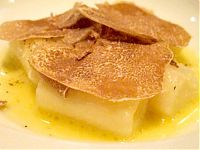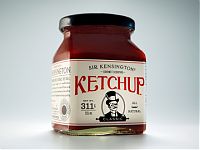Oregon: Wines on the Frontier
by Cynthia Sin-Yi Cheng
October 31, 2007
On my first trip to the Pacific Northwest, my main intention was to relax and discover outdoor Oregon, but of course even on vacation I couldn’t pass up visiting a few select wineries in this American wine frontier. The trip went splendidly. Now back in Gotham City, I’m typing up my report to share with you.
Just before leaving in late August, every magazine I leafed through had rave reviews accompanied by gorgeous photos of Portland’s Ace Hotel. Already intrigued by the understated décor coupled with a relaxed, quirky vibe, I had to check it out for myself, especially since I often find Manhattan boutique hotels lacking in unique identities.
I must say, my first impression was very, very good. Room 310 (see photo above), which I called home for a night, had a floor-to-ceiling hand-painted black-and-white mural by local artist Bwana Spoons of a Viking-looking-multi-eyed monster. It really set the mood for the room, and grew on me. The room was small as could be, but the smart and efficient layout suggested the fluidity of a larger space. The fixtures were bare and simple with lots of industrial, recycled material. Old wooden apple boxes, for example, served as bedside tables. Most pieces made utilitarian sense, most likely helped keep cost down, and worked as whimsical, sleek designs.
The 79-room hotel is located midway between the old downtown and the burgeoning Pearl District. All around it, a growing number of seemingly independent businesses are equally hip and, ostensibly, attuned to design. My favorite was a branch of the ubiquitous local Stumptown Coffee Roasters set to the right of the lobby. To the left sits Clyde Common, a restaurant with long communal tables and a bustling beat around the clock. Across the street, an art house cinema, Living Room Theaters, was screening several films on my “to see” list.
From Portland, I detoured to Oregon wine country for a short three-day stay. There was a lot to absorb in Willamette Valley, but here are the highlights:
Brick House Vineyards: Did you say an American Gamay?
Driving down Lewis Rogers Lane past an English-style brick house in Ribbon Ridge, I found myself at Doug Tunnell’s winery named after the house he lives in with his wife and winery co-owner, Melissa. Certified organic since it’s inception in 1990, Brick House is a pioneer in the industry, and Doug is already looking into solar power farming. He explains, “No solar cellars are in place yet, but we’re studying the technology.” This is a winemaker who cares about the environment and is light years ahead of his peers in his efforts to produce wines sustainably.
I like Brick House’s focus. Just the three Burgundy varietals: Chardonnay, Pinot Noir, and Gamay Noir. They produce two lines of Chardonnay, five Pinot bottlings (“Select,” “Cuvée du Tonnelier,” “Les Dijonnais,” “Evelyn’s,” and the just-launched cuvée “Boulder Block”), along with a surprisingly stunning Gamay Noir. I’ve been a big cheerleader for Gamay from small batch Beaujolais Nouveau to the top-of-the-line cru Beaujolais, so it was a real pleasure to discover an American interpretation so true to the soil and glory of this Burgundian grape.
I tasted several different barrel samples of the 2006 Gamay ($24) and could already anticipate the potential of the then soon-to-be bottled wine. Doug doesn’t believe Gamay benefits from new oak, so only older barrels are used here. Another wonderful little surprise he shared from his barrels was a work-in-progress blackberry port-like wine. It just makes sense for someone who has mastered Gamay to have a fruit-based dessert wine, too. And just as I expected, it was equally lush and true to the fruit. What can I say? I can hardly wait!
Lange: Second Generation Stepping Up
Given its fame around the globe today, it is easy to forget that Oregon is a very young wine region, only dating back to the 60s. The strongest impression from my visit is the exciting transition this wine region is undergoing. At barely fifty years old, first-generation winemakers are passing their craft on to an eager and talented second generation. So there is a new wave of young leadership at the helm: Jason Lett at Eyrie, Luisa Ponzi at Ponzi, Adam Campbell at Elk Cove, Ben Casteel at Bethel Heights, and Jesse, whom I met at his family’s winery, Lange, in Dundee.
Jesse was who reminded me of Oregon wine country’s youth, which makes it all the more impressive. Having just turned thirty this month, Jesse is suitably laidback while clearly a seasoned professional. Presently general manager and winemaker at Lange, he has been making wine alongside his dad, Don, the founder of the winery, for the past five years. He has also already spent time abroad studying enology and viticulture — with a special focus on Chardonnay and Pinot Noir — at Lincoln University in Canterbury, New Zealand.
Determined to make the Dundee Hills AVA known to the public, Jesse helped create the Dundee Hills Winegrowers’ Association to showcase the specificity of the red Jory soil of the terroir. This two-year old organization hosts an annual passport event and “Dundee Hills Wine Experience” encouraging the public to discover this little-known area. Presently, Lange owns sixty acres here alongside neighboring wineries such as Argyle, Domaine Drouhin, Eyrie, and Sokol Blosser.
I was able to sample the 2005 Dundee Hills Estate Vineyard Pinot Noir ($60), which revealed both vibrancy and earthiness in the form of autumnal spices (think cardamom and nutmeg) and clay soil. The down-to-earth characteristics of this unique terroir lingered long after I left Dundee.
Argyle: Oregon Sparkling Wine Making a Name
When Rollin Soles met me at Argyle’s tasting room, I really had no idea he was the owner of the winery. Can someone be more relaxed and inconspicuous? But he was clearly in charge when he led me into a sterile room right next to the lab — which Rollin refers to as his “temple of blending” — where we started to taste through his entire line-up of bubblies. This brought up a pressing question I knew he would be able to answer: “Why is it that given Oregon’s main focus on Pinot and Chardonnay — the two traditional Champagne grapes – we are not seeing more sparkling wines?” Rollin answered in simple economic terms. Basically, it’s the high capital investment, time needed for aging before release, and the lack of technical expertise. So there he is, solo, at least in the extent to which he produces sparkling wines in Willamette.
He covers a wide range of styles from the basic brut to blanc de blancs, Pinot-heavy blends, blanc de noirs, and rosé. All are vintage bruts. Argyle also makes still wines spanning from Riesling to Merlot. With just a handful of American producers committed to making serious sparkling wines, Argyle is among the major players.
I was blown away by the 1997 Extended Tirage Brut ($40), a blanc de noirs sourced from the Knudsen Vineyard. This just-released wine is 80% Pinot and 20% Chardonnay. It’s rare enough to see good Pinot-heavy blends coming from Champagne; this wine really hit me. The ten long years on lees (the process where the wine comes into contact with the dead yeasts in the bottle) allowed this wine the time to mature and develop a rich, creamy texture revealing what happens when Pinot is given the time to evolve after second fermentation. This wine is complex without being unapproachable. Again, showing that aged champagne is a style that should be enjoyed more often.
St. Innocent: A New Winery from from an Old Giant
All winemakers can be described as “hands on,” and Mark Vlossak at St. Innocent is the quintessential example of a winery founder who has his hands — literally — in every aspect of his company, from building his own winery equipment (ie. conveyor belt system) to having once given himself six stitches after a mishap with a brand new set of clippers in a vineyard.
Needless to say, my visit with Mark was a bit unusual. Rather than meeting at the tasting room or winery facility, I was greeted by the infamous maker of some of Oregon’s best single-vineyard Pinots at his new winery under construction in Eola-Amity Hills. What was unusual, though, was that he was not just overseeing the construction but actually moving fifteen hundred-gallon tanks around in a scissor lift. It seemed as if he was building the entire structure himself.
I didn’t taste any wine or walk through any vineyards at St. Innocent; instead, I had the rare honor of walking through the entire construction site with Mark as my guide. The new four-story winery located in Zenith Vineyard encompasses 7,500 square feet and will host a tasting room, barrel rooms, temperature-controlled crush floor, kitchen, an 800-guest wedding facility, to-die-for views of Zenith Vineyard, and an outdoor terrace.
Mark was able to explain in detail where every item will go in the soon-to-be industrial kitchen. He elaborated on how his design would make the most sense of the workstations for the catering staff: why the oven is where it is, the dishwasher, and so forth. He would know since he is a hands-on chef at home. So even though I was walking through a practically empty concrete space, thanks to Mark’s careful description and clear vision, it was as if I had been touring a fully furnished and operating winery. The tasting room is due to open by January of 2008. Stay tuned.
Adding to the exciting news is the relaunch of St. Innocent sparkling wines. After a five-year break (the last sparkling vintage dates from 2000), Mark is back at the game. Anticipate a 1998 late disgorged brut to be released soon. The newer vintages will be aged for six years before we’ll get to taste them, so be patient. The 2006 Brut will show its face to the public in 2013 (along with a new blanc de blancs!).
Soter: A Gem in Every Way
The drive up the hill to Soter’s Mineral Springs vineyard is quite grand. The narrow road winds up a panoramic hill lined with Ponderosa pines and Oregon oaks, where I was greeted by Chris Poulos, Soter’s sales and marketing coordinator, at an especially scenic spot to taste some new releases. Next to me was a small vegetable garden, and before me, the under-construction by-appointment-only tasting room due to open next summer. Chris set up the tasting on a picnic table right under several majestic Douglas firs overlooking the northwest corner of Willamette Valley on one side and the vines of Mineral Springs on the other.
When I took my first sip of the 2003 Brut Rosé ($45), I must have looked like I was drunk happy. I hate comparing sparkling wine to champagne as I feel there is a place for both, and the comparison is pointless given the specific terroir of different wine regions. However, I do believe it is a compliment to the winemaking when a sparkling wine is said to taste like champagne. That was just the case with this rosé. I was struck by the fineness of the pearlage, layers of red fruits (preserved Chinese plums stood out the most to me), and the precise six-gram dosage which balanced the sugar level and acidity of the wine. The blend of 2/3 Pinot and 1/3 Chardonnay contributed to a cherry tone wine. I enjoyed the subtlety and elegance of this Soter gem. Watch for a blanc de blancs to come soon.
In new releases is the recent launch of Soter’s flagship single-vineyard Pinot from Mineral Springs ($60). I had the extradorinary experience of tasting it while overlooking the very vineyards from which it was harvested. I was surrounded by this terroir as I both stared at it and drank it in! The 2005 (the first harvest) revealed the acidity of grapefruit, sweet fruit of dark cherries, and an earthiness from forest mushrooms. It’s richly elegant. Producing only 500 cases, this is a winery that keeps production small and quality high.
I was high after leaving Soter to head back to Portland where I would spend one more night at Ace Hotel. Maybe my first night there had set the bar too high, but my return was a bit of a let down as I discovered, despite the unique décor of every room, not all rooms were equal. One wall of my new room, 327, was papered with pages from a book, and there was a freestanding bathtub, but otherwise it was a bit generic. I still enjoyed my coffee at Stumptown, the photo booth in the reception area, lounging in the lobby with my newspaper or just staring at the beautiful botanical arrangement on the spacious coffee table. But one’s overall experience at Ace will certainly be room-dependant, so choose well. Nevertheless, room 327 did not put a damper on my trip. As I packed my things to leave Ace Hotel, I reminisced on the individual efforts of each of the winemakers I visited, and I am in awe of the winescape in Willamette Valley. There is a genuine sense of independence and singular focus that is supported by a bigger like-minded community. And isn’t this, afterall, the true spirit of the frontier?




















